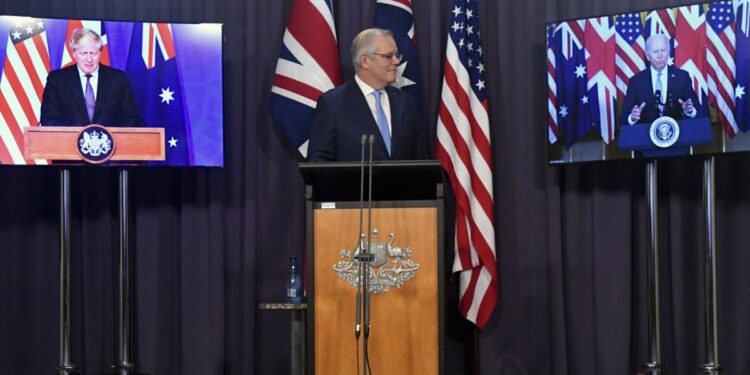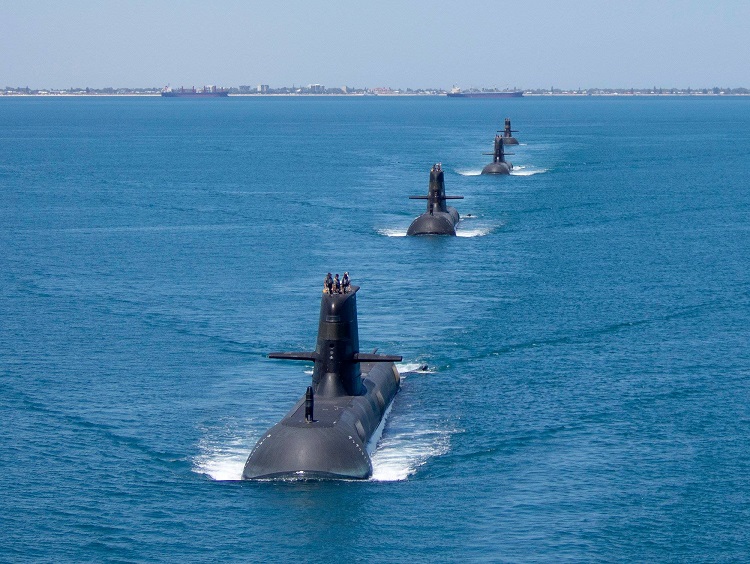
UK Labour Party criticizes AUKUS submarine deal.
Proposed US/UK Nuclear-powered Submarines for Australia
Risk Escalating an Arms Race No One Can Win
Beyond Nuclear International
Joint Statement by International Physicians for the Prevention of Nuclear War and its affiliates in Australia, UK and USA: Medical Association for Prevention of War (Australia); Medact (UK); Physicians for Social Responsibility (USA)
(October 10, 2021) — Physicians in the countries involved in the proposal announced on 16 September for Australia to acquire nuclear-powered submarines with UK and US assistance are concerned this plan will jeopardise global health and security. Under this proposal, Australia would become the seventh country to use nuclear propulsion for its military vessels, and the first state to do so which does not possess nuclear weapons, or nuclear power reactors.
These submarines are to be armed with sophisticated long-range missiles including US Tomahawk cruise missiles. These submarines would increase tensions and militarisation across Asia and the Pacific region, fuel an arms race and risk deepening a new cold war involving China.

Australian submarines in formation.
The Wrong Decision at the Wrong Time
Humanity is in the midst of a major pandemic, and facing twin existential threats of dire urgency — global heating and the growing danger of nuclear war. People everywhere desperately require our leaders to work together to address these major challenges, which can only be solved cooperatively.
Beginning on November 1, the UN Climate Change Conference will be held in Glasgow, when leaders have a choice to condemn humanity to cascading climate catastrophe, or step up and take the decisive and ambitious actions needed to drastically reduce greenhouse gas emissions and keep warming within 1.5 degrees. COVID vaccines are still out of reach for most of the world’s poor people. If ever there was a time to build goodwill and focus on cooperation to complex global problems rather than escalate military confrontation, that time is now.
Our leaders should be focussing their energies not on escalating a new cold war arms race with China, but on building peaceful cooperation to address urgent shared threats with the government of the world’s most populous and largest greenhouse gas emitting nation.
Instead, this plan will raise tensions, make cooperation more difficult, drive proliferation of ever more destructive weapons, divert vast resources needed to improve health and well-being and stabilise our climate, and increase the risks of a slide to armed conflict between the world’s most heavily armed states, risking nuclear escalation in which there can be no winners.
Spreading Nuclear Bomb Fuel
Commendable international efforts over decades to reduce production, use and stockpiles of highly-enriched uranium (HEU) worldwide have been supported by Australia, UK and US, including through the Nuclear Security Summits led by President Obama. In its role as G7 president, the UK has committed to ‘reinvigorate the aim of minimising production and use of Highly Enriched Uranium (HEU)’.
UK and US nuclear-powered submarines use HEU as fuel, which is directly usable in nuclear weapons, including those of the simplest design easiest for terrorists to build. Indeed their current naval reactor fuel is enriched to 93% and was originally produced for use in nuclear warheads. They have resisted and delayed efforts to convert their naval reactors to much less proliferation-prone low-enriched uranium fuel, as France and China have done, and any conversion to LEU is not likely before the late 2030s at the earliest.
So it seems very likely that any Australian nuclear submarines built with US or UK naval reactors over the next 20 years will also use HEU. Precisely because of the proliferation dangers of naval reactor fuel, the US has previously gone to considerable lengths to thwart the spread of naval reactors, such as in the 1980s blocking Canada from buying nuclear attack submarines from France and the UK.
A loophole exists in the international safeguards required under the nuclear Non- proliferation Treaty (NPT): states without nuclear weapons can remove fissile materials (which can be used to build nuclear weapons) from safeguards for a temporary period for use in military applications short of nuclear weapons. No nation has yet done this in relation to naval nuclear reactors.
The quantities of HEU involved are large. As Sebastien Philippe from Princeton University has estimated, a fleet of between 6 and 12 nuclear submarines as proposed, operated for about 30 years, will require between 3 and 6 tons of HEU. The International Atomic Energy Agency (IAEA) stipulates that 25 kg of HEU would enable a nuclear weapon, even though US nuclear weapons are known to contain an average of only 12 kg of HEU.
So HEU fuel for the proposed Australian submarines would involve 120 to 240 times the amount of HEU as the IAEA stipulates is sufficient to build a nuclear weapon, and it could be out of international safeguards for decades. Philippe has aptly characterised this as “a terrible decision for the non-proliferation regime”. It discredits all three nations’ claims to support a treaty curbing fissile materials, and would make such a treaty harder to verify.
The Australian government proclaims its support for strong nuclear safeguards, while falsely claiming that the safeguards obligations in the UN Treaty on the Prohibition of Nuclear Weapons (TPNW) are weaker than those under the NPT 3 (they are, in fact, stronger). Its plan to drive large amounts of HEU in reactors roaming the oceans for decades through a loophole in its safeguards does not indicate good faith on safeguards and non-proliferation.
This proposal needs careful independent scrutiny and strong new safeguards provisions to ensure Australia fulfills its obligations under both the NPT and the South Pacific Nuclear Free Zone Treaty. The latter goes further than the NPT in prohibiting the stationing of any nuclear explosive device in the territory of a state party.
The UK announcement in March of a planned 40% increase in its nuclear arsenal is in breach of its NPT obligations, as the UN Secretary-General has stated. The UK and US are modernising their nuclear arsenals, both in breach of their now 51-year-old legally binding NPT commitment to disarm.
Australia acquiring nuclear-powered submarines could well encourage other states, such as South Korea, Japan and Iran to pursue a similar path. Proliferation of submarines or other vessels with lifespans of several decades that are fuelled by weapons-grade HEU will encourage uranium enrichment, wider use and storage of HEU, and will set back and make more difficult control and elimination of fissile materials.
Radioactive Risk
Nuclear reactors on ships and submarines have been involved in numerous accidents. The risks of accident or attack causing release of radioactive material combined with the targeting by adversaries of such vessels including while they are in port, are why many cities around the world sensibly oppose visits of such vessels to their harbours. Such incidents could cause chaos and panic, the need to evacuate large areas of cities for years, and expose tens or hundreds of thousands of people to harmful radioactive fallout.
Australia’s lack of nuclear scientific, engineering, management and regulatory capacity and experience will inevitably mean that more is likely to go wrong building and operating nuclear submarines. If something does go wrong with one of its nuclear submarines, the likelihood of it being quickly and effectively managed is reduced and the risks of radioactive release in a port city or into the marine or coastal environment is increased.
A total of 8 nuclear-powered submarines have sunk because of accidents at sea between 1963 and 2003 – two because of fires, two by weapon explosions, two by flooding, and one each from storm damage and unknown reasons. These contribute substantially to the already widespread radioactive pollution resulting from naval reactors. The most recently reported fatal accident was a fire in a Russian nuclear submarine in 2019, which killed 14 people.

TheSoviet K-159 sank on August 30, killing 9.
Between 1963 and 2003, 8 nuclear subs were lost at sea.
The radioactive waste from reactors poses a difficult and expensive problem to manage health and environmental hazards for geological time periods. The governments involved in this proposal have been silent about disposal of the high and intermediate level waste that would be generated. Despite many flawed and failed attempts at interim storage, Australia has no current plan for disposal of the much smaller amount of its existing intermediate level radioactive waste.
A Step Towards Nuclear Power and Nuclear Weapons?
Already, in the wake of the announced plans, there are mounting calls in Australia, including from some government MPs, for Australia to embrace nuclear power as well. Throughout the 1950s and 1960, Australia made active plans and preparations to acquire nuclear weapons. Calls that Australia needs to be prepared to acquire its own nuclear weapons, from former senior government officials and those employed by think tanks close to the government, have never gone away.
Twenty nuclear weapons could be built from the amount of HEU fuelling the nuclear reactor of each planned submarine.
The Way Forward
More than a leader’s word is needed to ensure that the planned submarines will not be used as the thin end of a wedge towards an expanded civil nuclear industry, such as nuclear power generation, and that the planned submarines will not be armed with US, UK or Australian nuclear weapons.
Rather than escalating a nuclear-propelled new cold war, both the UK and US should make their people and the world truly safer by pursuing a verifiable and binding agreement with other nuclear armed states to eliminate their nuclear arsenals. They should welcome and work towards joining the 2017 UN Treaty on the Prohibition of Nuclear Weapons (TPNW), which provides the only internationally agreed, treaty-codified framework for the elimination of nuclear weapons. Naval nuclear propulsion, especially with HEU, should be phased out.
There are abundant compelling reasons for all states to join the TPNW — indeed that is the best test of whether they are serious about nuclear disarmament, or not. Contrary to its support for the treaties prohibiting all other major types of inhumane and indiscriminate weapons and weapons of mass destruction — biological and chemical weapons, landmines and cluster munitions — Australia opposes the TPNW.
The best way for Australia to provide surety that any nuclear-powered submarines would not be a stepping stone towards acquiring nuclear weapons, nor have any role in the possible use of nuclear weapons, is to join the TPNW. If it continues to refuse to do so, such concerns will remain well justified.
If Australia does proceed to acquire nuclear submarines, it should insist on LEU fuel, implement stringent safeguards, the submarines should be configured so that they cannot carry nuclear weapons, and nothing about their construction or operation should impede Australia joining the TPNW.
For the full joint IPPNW statement with signatures, go here.
Posted in accordance with Title 17, Section 107, US Code, for noncommercial, educational purposes.